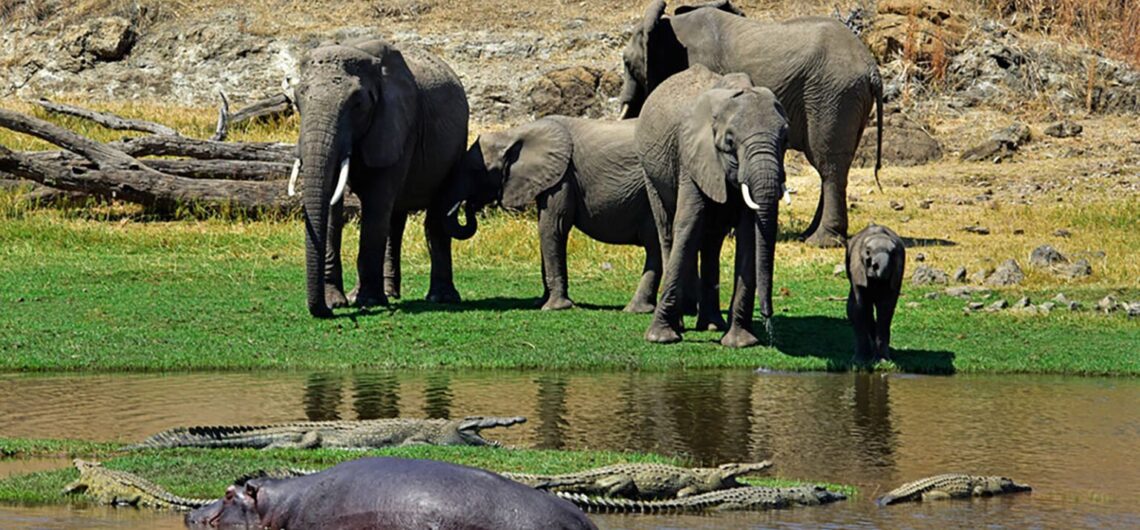Ruaha National Park is one of Tanzania’s largest national parks, covering over 20,000 square kilometers. Situated in the heart of the country, it is known for its diverse wildlife and stunning landscapes, including savannah, river systems, and baobab-dotted plains. The Great Ruaha River, home to hippos and crocodiles, runs through the park, adding to its natural allure.
The park hosts an impressive array of wildlife, including elephants, lions, leopards, giraffes, zebras, and various antelope species. It is particularly renowned for its large elephant population, with herds migrating through the park. Birdwatchers also flock here for the park’s rich birdlife, boasting over 570 bird species.
Ruaha offers exceptional safari experiences with its vast and relatively untouched wilderness, providing visitors the chance to explore its diverse ecosystems and encounter wildlife in a more secluded setting compared to some of Tanzania’s parks that are more famous. Its remote location contributes to its reputation as a hidden gem among safari enthusiasts.
Accessing Ruaha National Park
Accessing Ruaha National Park by Air: Visitors can access Ruaha National Park via flights from Dar es Salaam, Dodoma, or Arusha to Iringa, which is the closest major town. From Iringa, it is a drive to the park’s entrance gates.
Accessing Ruaha National Park by Road: It is also accessible by road from Iringa or even from other major tourist destinations like Selous or Mikumi National Park. The roads are typically usable during the dry season but might be challenging in the wet season.
Attractions in Ruaha National Park
Ruaha Gorge: one of the Attractions in Ruaha National Park. Ruaha Gorge is a deep and rugged part of Ruaha National Park. It is like a big crack in the land with tall cliffs. Animals often come here for water, making it a good spot for wildlife watching. The gorge offers amazing views of the landscape, and you can see animals against the rocky backdrop. It is a special place within the park where you can experience the park’s wild beauty up close.
Bird watching: Ruaha National Park is a bird watcher’s dream. With over 570 bird species, including vibrant kingfishers, eagles, and unique hornbills, it is a colorful paradise. The park’s diverse habitats, like riversides and forests, attract different birds year-round. Mornings and late afternoons are prime times for spotting active birds. Guides help identify birds by their sounds and behaviors. Bring binoculars and a bird guidebook for better viewing. Overall, it is a fantastic place for bird lovers to enjoy nature’s feathered wonders.
Wildlife: as one of the attractions in Ruaha National Park. Ruaha National Park is home to lots of amazing animals. You will find big herds of elephants wandering around, along with lions, leopards, giraffes, zebras, and antelopes. The Great Ruaha River is a hotspot for wildlife, especially during the dry season when animals come for water.
The park has a diverse mix of habitats, like savannah and forests, which different animals call home. Spotting wildlife is easier during morning and evening safaris when animals are most active. The elephants here are famous for their big herds. Lions roam the plains while leopards hide in trees. You might even see wild dogs, buffaloes, and hippos by the river. Overall, Ruaha is a haven for wildlife lovers, offering incredible opportunities to see these animals in their natural habitat.
Walking safaris: In Ruaha National Park, walking safaris are exciting adventures. Guides lead small groups on foot through the park’s wild spaces. You get up close to nature, exploring the wilderness, and discovering animals and plants. It is a chance to learn about tracks, birds, and smaller creatures you might miss on a vehicle safari. These walks are safe and thrilling, letting you experience the park in a completely new way.
The Great Ruaha River: This River is very important in Ruaha National Park. It is like a lifeline for animals, especially during dry times. Animals gather here for water, so it is a top spot for seeing wildlife. You can spot hippos chilling in the water and crocodiles sunbathing on the banks. Many birds hang out here too, fishing and resting by the river. It is an awesome place for safaris, giving you a front-row seat to wildlife action.
Cultural encounters: In Ruaha National Park, you can meet local groups of people like the Barabaig nearby. They sometimes share their traditions and ways of life with visitors, showing their unique culture. You might learn about their traditional dances, crafts, or even how they live off the land. It is a chance to understand their customs and stories, making your visit more meaningful and diverse. These cultural encounters add a special touch to your safari experience, offering a glimpse into the local community’s rich heritage.
Accommodation facilities in Ruaha National Park
Ruaha offers various accommodation options to suit different preferences and budgets:
Lodges: There are several lodges and luxury tented camps within and around the park, offering comfortable stays and guided safaris. These include Mdonya Old River Camp, Kwihala Camp, Jongomero Camp, and Ruaha River Lodge.
Campsites: For those seeking a more adventurous experience, there are public campsites available within the park. Prior booking and arrangements might be necessary.
Please note:
It is important to note that due to the park’s remote location, facilities might not be as numerous or easily accessible as in more touristy areas. It is advisable to plan and book accommodations and safaris in advance, especially during the high season (June to October) when the park is at its busiest and wildlife sightings are abundant. Additionally, hiring a local guide or joining a guided safari is recommended to enhance your experience and navigate the park safely.


Comments